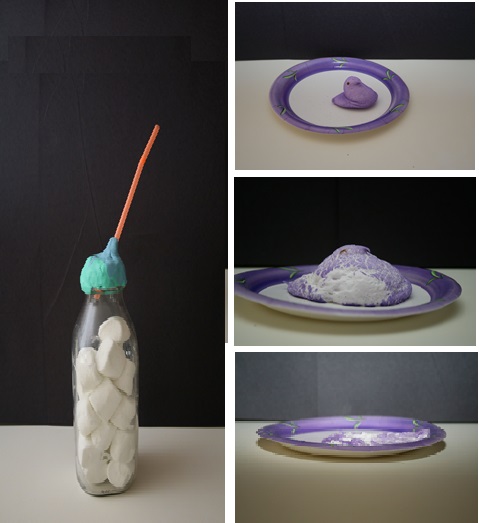
You can use these air bubbles, and a little science to make marshmallows change size.
Expand Marshmallows by Making a Vacuum
Materials
• Glass or thick plastic bottle
• Clay
• Drinking straw
• Marshmallows
1) Put some marshmallows in the bottle.
2) Use the clay to seal the top of the bottle. Poke a hole in the clay and put the drinking straw through it. Seal the hole by pressing the clay up against the straw
3) Suck on the straw to remove the air from the bottle. Watch the marshmallows carefully! They will begin to expand as the air is removed.
If you have trouble seeing the marshmallows expand, watch what happens when you stop sucking on the straw. The air rushes back into the bottle and the marshmallows will contract immediately. It’s easier to see this because it happens suddenly.
Expand Marshmallows by Heating
Materials
• Microwave oven
• Paper plate
• Marshmallows (Marshmallow Peeps are fun to use)
Be careful—the marshmallow gets very hot!
1) Put a marshmallow on a paper plate and place it in the microwave oven.
2) Set the timer on the microwave oven for 30 seconds (start with this time and make it longer, if necessary)
3) Watch what happens! (This is a dramatic demonstration) Take the marshmallow out of the oven and watch what happens as it cools off. Be very careful, the marshmallow will be extremely hot.
Why does this work?
The air bubbles inside marshmallows may seem empty, but they are actually full of gas molecules. The molecules are moving around, which creates pressure that pushes out on the marshmallow. Normally, these forces are balanced by the molecules moving in the air around the marshmallow. The air pressure from the atmosphere pushes into the marshmallow. This keeps the marshmallow at a constant size. But, if you can change the forces either inside or outside the marshmallow, you can change the size of the marshmallow!
In the first experiment, you remove some of the gas molecules from the air surrounding the marshmallows in the bottle. Now the gas molecules trapped inside the marshmallow are pushing more strongly than the gas molecules outside. This makes the marshmallow expand (get bigger). When you let air back into the bottle, the force from the outside is again equal to the force on the inside and the marshmallow contracts (gets smaller).
In the second experiment, you heat the air inside the marshmallow (microwave ovens don’t heat the air surrounding the food, this is why you can use paper plates in a microwave, but not a regular oven). When you heat molecules, they move more quickly. This makes them hit the outside of the marshmallow with more force and causes the marshmallow to expand.







